Pedro Sáinz de Baranda y Borreiro facts for kids
Quick facts for kids
Pedro Sáinz de Baranda y Borreiro
|
|
|---|---|
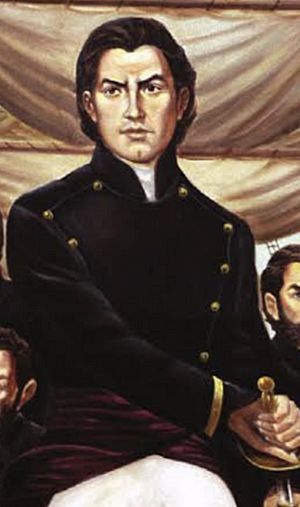 |
|
| Governor of Yucatan | |
| In office 3 January 1835 – 18 February 1835 |
|
| Preceded by | Francisco de Paula Toro |
| Succeeded by | Sebastián López de Llergo |
| Governor of Yucatan | |
| In office 22 June 1835 – 27 August 1835 |
|
| Preceded by | Sebastián López de Llergo |
| Succeeded by | José de la Cruz Villamil |
| Personal details | |
| Born |
Pedro Sainz de Baranda y Borreiro
13 March 1787 San Francisco de Campeche, New Spain |
| Died | 16 December 1845 (aged 58) Mérida, Yucatán, Mexico |
| Resting place | Campeche Cathedral (1845–1987) The Rotunda of Illustrious Persons (1987–present) |
| Political party | Liberal Party |
| Spouse | María Joaquina Quijano Cosgaya |
| Children | Pedro Baranda Quijano Perfecto Baranda Quijano María Josefa Baranda Quijano Joaquín Baranda Quijano |
| Parents | Pedro Sáinz de Baranda Cano (father) María Josefa Borreiro y de la Fuente (mother) |
| Education | Escuela Naval Militar |
| Military service | |
| Branch/service | |
| Years of service | 1803–1821 (Spanish Empire) 1821–1830 (Mexico) |
| Rank | Captain |
| Battles/wars | Battle of Traflagar (Anglo-Spanish War (1796–1808)) Siege of San Juan de Ulúa (Mexican War of Independence) |
Pedro Sáinz de Baranda y Borreiro (born March 13, 1787 – died December 16, 1845) was a very important naval officer, businessman, and politician in Mexico. He is known for creating the Mexican Navy. He also led a naval blockade of Veracruz that helped end the Mexican War of Independence. This happened when the Spanish finally gave up the San Juan de Ulúa fort in 1825. This was the last piece of Mexican land still held by Spain.
Pedro was born in San Francisco de Campeche to a noble Spanish family. His father was a government official for the Spanish Empire. At age eleven, Pedro went to Spain to train as a naval officer. He joined the Spanish Navy and fought in the famous Battle of Trafalgar. He was even injured but showed great bravery.
During the Mexican War of Independence, he played a big part in forming the Mexican Navy. He helped capture the San Juan de Ulúa fortress. As the head of the Navy Department, he held the highest naval position at that time. He also served in public roles. He was elected to the group that wrote the Spanish Constitution of 1812. Later, he helped write the Mexican Constitution of 1824. He was a member of the Liberal Party. He also served as mayor of Valladolid, lieutenant-governor of Yucatán, and twice as governor of Yucatán. He also helped explore Mayan culture. He started the Aurora Yucateca, which was Mexico's first modern textile factory.
Contents
Early Life and the Battle of Trafalgar
Pedro Sáinz de Baranda was born on March 13, 1787, in San Francisco de Campeche. He was the oldest son of Pedro Sáinz de Baranda y Cano, a Spanish official. His mother was María Josefa de Borreiro y de la Fuente. His family was part of the Spanish nobility. They were active in politics in both Spain and Mexico.
When he was 11 years old, in 1798, Pedro traveled to Spain. He went there to get training as a naval officer. He officially joined the Spanish army on October 18, 1803. He started as a midshipman, which is a junior officer. By November 1804, he was promoted to sub-lieutenant.
In 1796, Spain joined forces with France against Great Britain. A temporary peace treaty was signed in 1802. But fighting started again two years later. This happened after the British attacked a Spanish fleet carrying valuable metals.
Pedro Sáinz de Baranda served on the battleship Santa Ana. This ship was part of a Spanish fleet. This fleet met Admiral Nelson's British fleet near Cape Trafalgar. During the battle, the Santa Ana fought against the British ship HMS Royal Sovereign.
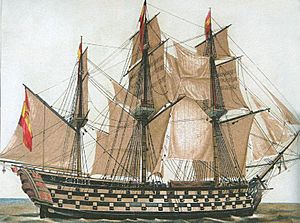
The battle was very fierce and lasted about six hours. The Santa Ana had many injured crew members. Pedro Sáinz de Baranda himself received three serious wounds. The Spanish ship had to surrender. However, other Spanish ships later rescued it. After the Battle of Trafalgar, Pedro was seen as a hero. He was promoted to lieutenant at the age of eighteen.
His serious injuries from the battle meant he could not stay in active naval service. He left his ship in March 1806. He then joined the Spanish Marine Infantry. Between 1806 and 1808, he continued to serve the Spanish Navy. He fought against the English and led several convoys. He showed great courage in a battle in Chipiona, Spain. This led to the capture of over eight thousand rifles.
In 1808, Pedro traveled from Europe to the Americas. He carried important documents about who would be the next king of Spain. He went to La Guaira, Venezuela, and then to Cuba. Finally, he returned to his hometown of Campeche in August 1808. There, he learned that France had invaded Spain. This made him want to serve again. He became the Second Commander on the warship Antenor. During the Napoleonic Wars, he carried out missions to Havana, Santo Domingo, and Pensacola. He also patrolled the Gulf of Mexico.
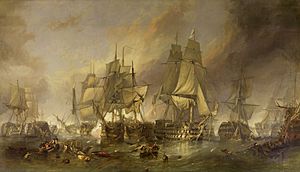
In 1810, at age twenty-three, he was chosen to be a representative. He joined the Cortes of Cádiz, which was the group that wrote the Spanish Constitution of 1812.
In 1815, Pedro was ordered to go to Havana to command a ship. But his health got much worse. He had severe eye problems that made it hard to serve in the navy. He asked to retire from the Spanish Navy. Because of his health, he was given a new role. On February 26, 1815, he was asked to join the Army's Corps of Engineers. His job was to oversee and strengthen the city's defenses.
The Mexican War of Independence had lasted for eleven years. On September 27, 1821, the Mexican army entered Mexico City. The next day, the Treaty of Córdoba was signed. This document officially made Mexico independent. However, some Spanish troops were still in Mexico. In the port of Veracruz, the Spanish soldiers refused to give up. They went to San Juan de Ulúa and continued to fight from there.
During the First Mexican Empire (1821-1823), Pedro Sáinz de Baranda served in the new Mexican Imperial Navy. On December 2, 1822, Antonio López de Santa Anna rebelled against the Empire. He declared that Mexico should be a republic. Pedro Sáinz de Baranda was the Commander of Veracruz. He refused to give Santa Anna ships from the Imperial Navy. He started a movement to keep the coastal towns loyal to the Empire. For this, he was promoted to Frigate Captain in January 1823. After the Mexican Empire fell, the new government confirmed his promotion.
In the early 1820s, Mexico had won its independence from Spain. But the Spanish soldiers still held San Juan de Ulúa. This was a very strong fort off the coast of Veracruz. San Juan de Ulúa was built in 1535 by Hernán Cortés. For many years, it protected the Spanish treasure ships. Even after Mexico became independent, Spain held onto the fort. They hoped to take Mexico back. The Spanish forces in the fort were led by José María Dávila García. They used the fort's location to their advantage. The Mexican government knew that capturing San Juan de Ulúa was vital. It would show Mexico's power and secure its coast.
Pedro Sáinz de Baranda was chosen to be the Commander of the Mexican Navy. His job was to build a navy strong enough to capture the fort. Pedro was a great leader. He knew a lot about the sea. He was also very dedicated to Mexico. This made him the perfect person for this big task.
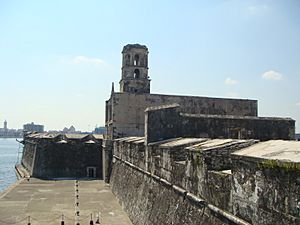
General Miguel Barragán tried to attack the fort from land, but it didn't work. So, Pedro Sáinz de Baranda came up with a plan. He decided to cut off the Spanish soldiers' supplies. He put together a small fleet of 200 sailors, 100 gunners, a frigate, and eight corvettes. Pedro carefully planned and carried out a naval blockade. He placed Mexican naval ships in key spots. This stopped supplies and messages from reaching the fort. Pedro faced many challenges, like not having enough supplies and bad weather. But he never gave up.
The big moment came in the fall of 1825. Spanish ships, including the frigates Sabina and Casilda, tried to break the blockade. They wanted to bring help to the fort. But Pedro Sáinz de Baranda skillfully organized the Mexican navy. They stopped the Spanish ships. Under his command, the Mexican Navy fought the Spanish fleet in a tough battle. The Spanish ships were forced to leave. This victory showed Pedro's smart planning. It also ended Spain's hopes of sending more help to the fort.
After this naval victory, Pedro Sáinz de Baranda used the Spanish forces' weak position. The Mexican Navy made its blockade even stronger. They cut off all important supplies to the Spanish soldiers. The constant pressure from Pedro and his navy made the Spanish forces inside the fort feel alone and hopeless.
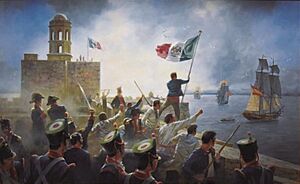
The Spanish forces in San Juan de Ulúa knew they could not win. They started talking about surrendering. Pedro Sáinz de Baranda played a key role in these talks. He made sure that Mexico's interests were protected. On November 13, 1825, the Spanish forces officially surrendered. This combined effort by the army and navy secured Mexico's independence forever. Spain gave up its last control over Mexican land.
Pedro Sáinz de Baranda's strong actions and excellent planning led to the fort's surrender. This made Mexico fully control this important coastal area. This achievement was a huge step for Mexico after its independence. It also made Pedro Sáinz de Baranda a national hero and a naval pioneer. To remember these important events, Mexico celebrates "Navy Day" on November 23. This was made official by President Carlos Salinas de Gortari. Because of his role, Pedro Sáinz de Baranda is known as the founder of the Mexican Navy.
Pedro Sáinz de Baranda held the highest naval position as the head of the Navy Department. However, his health was not good. On December 1, 1825, he asked the government to accept his resignation. He said there were no more armed enemies against the nation.
After 1830, he held many public jobs. He was mayor of Valladolid, lieutenant-governor of Yucatán, and governor of Yucatán twice. He was also chosen to be part of the group that wrote the Mexican Constitution of 1824.
Industrialist and Founder of Aurora Yucateca
In 1834, Pedro Sáinz de Baranda worked with a Scottish businessman named John McGregor. Together, they started the Aurora Yucateca. This was Mexico's first fully mechanized textile factory. It was also the first to successfully use steam power. This important project is seen as the start of the Industrial Revolution in Mexico. The Aurora Yucateca was a big step forward in making textiles. It also helped start industrial growth in the country.
Besides his work in industry, Pedro Sáinz de Baranda was also interested in culture and exploration. He worked with an American explorer named John Lloyd Stephens. They researched the mysterious Mayan civilization in the Yucatán Peninsula. This teamwork greatly improved our understanding of Mayan culture. Their efforts led to a famous book called Incidents of Travel in Yucatán. Stephens and artist Frederick Catherwood wrote this book together.
The Aurora Yucateca factory made great progress. But it faced a huge challenge during the Caste War of Yucatán. This war stopped the textile industry. The factory had to close down. The widespread destruction during this time unfortunately affected Aurora Yucateca, leading to its closure. This period of unrest was a big setback for both industry and the region. It was not until 1854 that another mechanized textile factory was founded in Monterrey.
Pedro Sáinz de Baranda died in Mérida on December 16, 1845. He was 58 years old. His body was buried in Campeche Cathedral. In March 1987, President Miguel de la Madrid ordered that his remains be moved. They were taken with military honors to the Rotunda of the Illustrious Persons in Mexico City.
Descendants and Their Achievements
Pedro married María Joaquina Quijano y Cosgaya. Her family, the Quijano family, was very powerful in Yucatán. They held important positions in local government, business, the church, and the military.
Pedro and María Joaquina had four children: Pedro, Perfecta, María Josefa, and Joaquín.
Pedro Sáinz de Baranda was also the stepfather of Francisco Cantón. Francisco was a conservative politician and military leader. He served as governor of Yucatán from 1898 to 1902. He helped modernize the region and boost its economy. He was a general who fought in the Caste War of Yucatán. He also supported Emperor Maximilian during the Second French Intervention. Later, he supported Porfirio Díaz in 1876.
Pedro Sáinz de Baranda's legacy continued through his children and grandchildren. They also made a mark on Mexico's politics and society. The Baranda family became very important in southeastern Mexico. They were known as a family from Campeche who were active in civil and military affairs for a long time.
One of his sons, Joaquín, became very famous. He was the chief justice of the Supreme Court. He also served as a governor of Campeche and a cabinet minister. He helped create important institutions like the Public Prosecutor's Office and the Normal School. This showed his dedication to improving Mexican society.
Another of Sáinz de Baranda's sons, General Pedro Baranda, was a military officer. He fought during the Reform War and the French invasion of Mexico. He led battles for the liberal cause. He also helped create the federal states of Campeche and Morelos. This showed his commitment to his country. He also helped write the 1857 Federal Constitution.
The family's influence grew even more. Pedro Sáinz de Baranda's great-grandson, José María Pino Suárez, became a key figure during the Mexican Revolution. Pino Suárez served as the vice-president of Mexico. He played a big role in this time of change. Sadly, he was assassinated in 1913.
See also
 In Spanish: Pedro Sáinz de Baranda y Borreiro para niños
In Spanish: Pedro Sáinz de Baranda y Borreiro para niños



